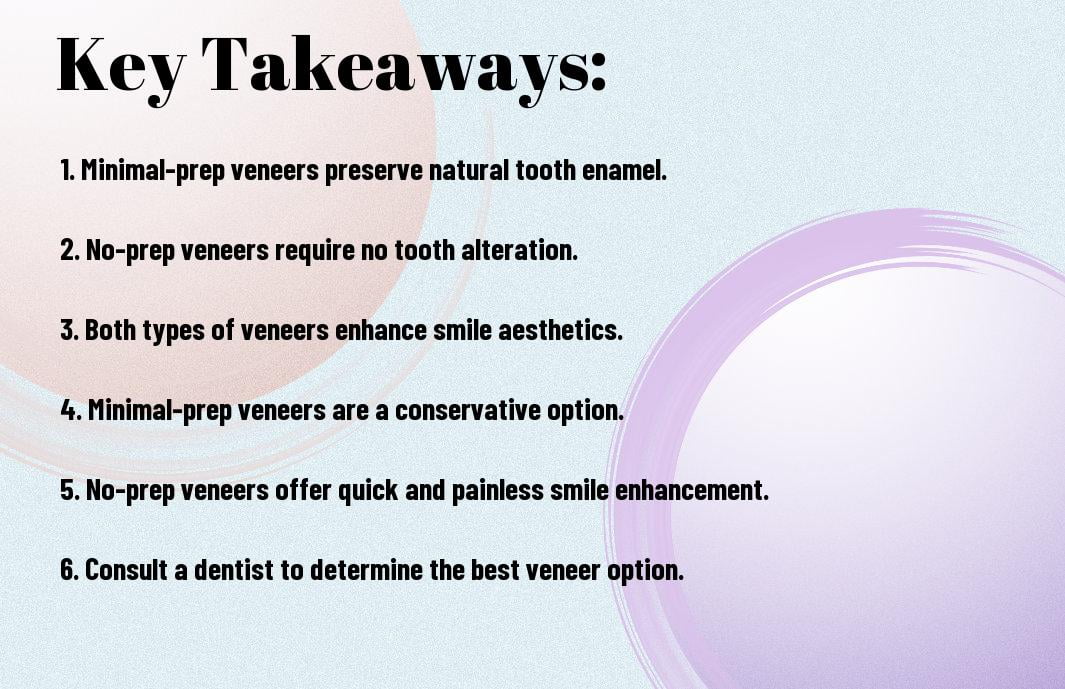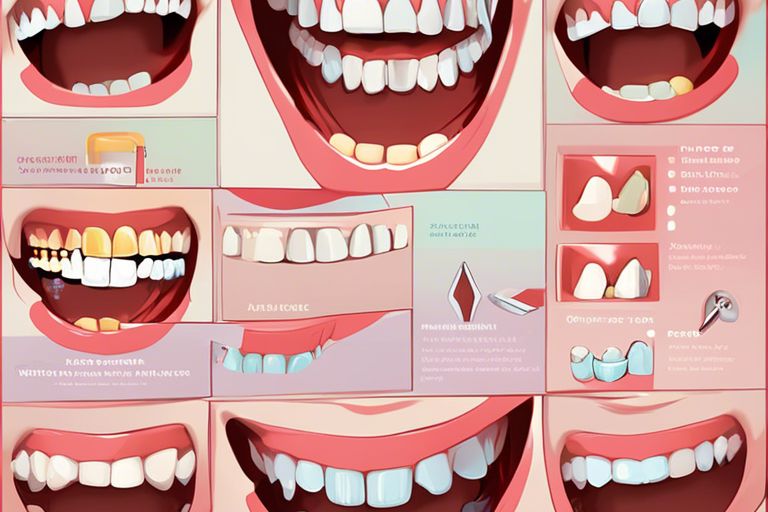There’s a revolutionary way to transform your smile without the need for extensive dental work – minimal-prep and no-prep veneers. If you’ve been considering enhancing your smile, these veneers offer a minimally invasive solution that can make a significant impact on your appearance. In this blog post, we will explore the benefits, process, and considerations of opting for these modern dental veneer options. Let’s investigate how you can achieve a radiant smile with minimal fuss!
Key Takeaways:
- Minimal-Prep and No-Prep Veneers: These innovative dental procedures offer a conservative and less invasive option for enhancing your smile compared to traditional veneers.
- Preserve Tooth Structure: Minimal-prep and no-prep veneers allow for the preservation of natural tooth structure, making them a more attractive option for those concerned about maintaining their teeth’s integrity.
- Natural-Looking Results: Despite being thin, minimal-prep and no-prep veneers can still provide natural-looking results, improving the appearance of your smile without compromising on aesthetics.
Enhancing your smile doesn’t have to involve drastic measures that may impact your natural teeth. With minimal-prep and no-prep veneers, you can achieve a brighter, more confident smile while keeping your teeth intact. These innovative procedures offer a balance between aesthetics and preservation, ensuring that you can smile with pride and comfort.
What Are Minimal-Prep and No-Prep Veneers?
Definition and History
What exactly are minimal-prep and no-prep veneers? Well, these dental veneers are ultra-thin shells made of porcelain or composite resin that are custom-designed to fit over the front surface of your teeth. Unlike traditional veneers that require some enamel removal for a proper fit, minimal-prep and no-prep veneers are designed to be affixed to your teeth with minimal to no alteration of your natural tooth structure. This means that the process is typically less invasive and more conservative compared to traditional veneers, making it an appealing option for enhancing your smile.
Evolution of Veneer Technology
For many years, traditional veneers have been a go-to solution for improving the appearance of teeth affected by stains, cracks, chips, or misalignment. However, as technology advances, the demand for more conservative options has led to the development of minimal-prep and no-prep veneers. These modern veneer options prioritize preserving your natural tooth structure while still providing a solution for enhancing the aesthetics of your smile. With the evolution of veneer technology, you now have the opportunity to achieve a beautiful smile with minimal discomfort and alteration to your teeth.
Veneer technology has come a long way, offering you more choice and flexibility in enhancing your smile. With minimal-prep and no-prep veneers, you can now achieve a stunning smile makeover with less hassle and more comfort. These innovative veneer options provide a conservative approach to smile enhancement, allowing you to achieve the smile of your dreams with minimal disruption to your natural teeth. So, if you’re looking to enhance your smile without extensive enamel removal, minimal-prep and no-prep veneers may be the perfect solution for you.
Benefits of Minimal-Prep and No-Prep Veneers
Preserving Natural Tooth Structure
Even though traditional veneers require some reduction of your natural tooth enamel to ensure a proper fit, minimal-prep and no-prep veneers offer a conservative alternative. By opting for these types of veneers, you can preserve the majority of your natural tooth structure while still achieving a radiant smile. This means that your teeth remain largely intact, and the process is reversible if you ever decide to remove the veneers in the future.
Minimally Invasive Procedure
One of the significant advantages of minimal-prep and no-prep veneers is that the procedure is minimally invasive. Unlike traditional veneers that may require more extensive preparation and alterations to your teeth, minimal-prep and no-prep veneers involve a less intrusive process. This results in a quicker and more comfortable experience for you, with minimal disruption to your natural teeth.
Additionally, minimal-prep and no-prep veneers often do not necessitate numbing injections or drilling, making it a gentler option for those with dental anxiety or sensitivity. With this approach, you can enhance your smile without the discomfort or inconvenience typically associated with extensive dental procedures.
Quick and Painless Application
Invasive techniques are not required for the application of minimal-prep and no-prep veneers, ensuring a quick and painless process for you. The application typically involves minimal tooth preparation, if any, followed by the secure bonding of the veneers to the front surface of your teeth. You can expect to leave your dental appointment with an instantly improved smile, without the need for extended recovery time or discomfort.
This efficient and straightforward application method makes minimal-prep and no-prep veneers an appealing option for those looking to enhance their smile with minimal hassle. The convenience of the process allows you to achieve your desired aesthetic results promptly and comfortably, giving you the confidence to flash your new smile without delay.
Candidates for Minimal-Prep and No-Prep Veneers
All candidates for minimal-prep and no-prep veneers share the desire to enhance their smile without extensive dental work. These veneers offer a minimally invasive solution to address various cosmetic concerns, functional issues, and restorative needs.
Cosmetic Concerns
Minimal-prep and no-prep veneers are an excellent option for individuals looking to improve the appearance of their teeth. If you have stains, discoloration, gaps, uneven teeth, or minor alignment issues that you wish to correct, these veneers can provide a natural-looking and durable solution for your smile.
Functional Issues
To determine if you are a suitable candidate for minimal-prep or no-prep veneers based on functional issues, your dentist will assess your bite alignment, tooth wear, and any signs of decay or damage. These veneers can help reinforce weak enamel, improve tooth strength, and enhance overall oral function while maintaining a conservative approach to treatment.
This type of veneer is ideal for individuals with healthy teeth who are looking to address functional concerns without the need for more extensive dental procedures. If you have minor chips, cracks, or wear on your teeth that affect how you bite or chew, minimal-prep or no-prep veneers could be the right choice for you.
Restorative Needs
With minimal-prep and no-prep veneers, you can address underlying restorative needs such as strengthening weakened enamel, repairing small areas of damage, and improving the overall structure of your teeth. These veneers are a conservative option that can enhance the appearance and function of your smile while preserving more of your natural tooth structure.
It is important to consult with your dentist to determine if minimal-prep or no-prep veneers are suitable for addressing your specific restorative needs. Your dentist can assess the condition of your teeth and recommend the best treatment option to help you achieve a healthy and beautiful smile.
The Procedure: What to Expect
Consultation and Planning
What you can expect during the initial consultation for minimal-prep or no-prep veneers is a thorough examination of your teeth and discussion about your desired outcome. Your dentist will evaluate your oral health and determine if veneers are suitable for you. They will also take impressions of your teeth to create custom veneers that will enhance your smile.
Preparation and Bonding
On the day of the procedure, your dentist will prepare your teeth by lightly etching the surface to create a strong bond with the veneers. Minimal-prep and no-prep veneers require little to no enamel removal compared to traditional veneers, making the process quicker and less invasive. The veneers are then carefully bonded to your teeth, creating a natural and seamless appearance.
Consultation for the procedure should involve discussing your goals with your dentist. You can bring in photos of smiles you admire to help convey the look you are hoping to achieve. Your dentist will work with you to customize the shape, color, and size of your veneers to ensure they complement your facial features and achieve your desired aesthetic.
Placement and Adjustment
To ensure the perfect fit and alignment of your minimal-prep or no-prep veneers, your dentist will carefully place them on your teeth and make any necessary adjustments. This step is crucial in achieving a beautiful and natural-looking smile. Your dentist may trim and shape the veneers to ensure they blend seamlessly with your existing teeth.
This final step in the process involves checking your bite and making any final adjustments to ensure your comfort and satisfaction with your new veneers. Your dentist will provide you with aftercare instructions to maintain your veneers and keep your smile looking its best for years to come.
Advantages Over Traditional Veneers
Reduced Sensitivity
To enhance your smile with minimal-prep and no-prep veneers, you can enjoy reduced sensitivity compared to traditional veneers. Veneers that require less preparation mean that less enamel is removed from your teeth, resulting in a more conservative approach. This minimal alteration to your natural teeth can lead to a more comfortable experience, with less likelihood of sensitivity after the procedure. Additionally, the thinner nature of these veneers can provide a more natural look and feel, enhancing your smile without compromising on comfort.
Less Invasive Preparation
With minimal-prep and no-prep veneers, you benefit from a less invasive preparation process. Traditional veneers often require significant enamel removal, which can be irreversible and may lead to increased sensitivity. However, by opting for veneers that require minimal to no preparation, you can achieve a transformed smile with minimal disruption to your natural teeth. This conservative approach can be appealing for those who are concerned about the long-term effects of extensive enamel removal.
This less invasive preparation also means that the application process is typically quicker and more comfortable. Your dentist can place minimal-prep or no-prep veneers with a focus on preserving your natural teeth, ensuring a seamless and efficient procedure that enhances your smile with minimal discomfort.
Faster Recovery Time
With minimal-prep and no-prep veneers, you can benefit from a faster recovery time compared to traditional veneers. The reduced enamel removal and minimal alteration to your teeth mean that your recovery period is often shorter and more comfortable. You can enjoy your enhanced smile sooner without the extended recovery period associated with traditional veneers.
For instance, you may experience less post-procedure discomfort and a quicker adjustment to your new veneers with minimal-prep or no-prep options. This faster recovery time can make the process of enhancing your smile more convenient and less disruptive to your daily routine.
Caring for Your Minimal-Prep and No-Prep Veneers
After getting your minimal-prep or no-prep veneers, it’s vital to take good care of them to ensure they stay looking beautiful and last a long time. Proper maintenance and regular check-ups are key to preserving your enhanced smile.
Oral Hygiene and Maintenance
Caring for your minimal-prep or no-prep veneers involves maintaining excellent oral hygiene practices. Brushing your teeth at least twice a day and flossing daily are crucial to prevent plaque buildup and maintain the health of your veneers. Using a non-abrasive toothpaste and a soft-bristled toothbrush will help avoid scratching or damaging the veneers.
Avoiding Damage and Wear
Your new minimal-prep or no-prep veneers are durable but not indestructible. It’s important to be mindful of certain habits that can cause damage or premature wear to your veneers. Avoid biting on hard objects, such as ice or pens, and refrain from using your teeth to open packages or bottles. Additionally, be cautious of teeth grinding or clenching, as this can lead to chipping or cracking of the veneers.
Regular Check-Ups and Monitoring
Caring for your minimal-prep or no-prep veneers includes scheduling regular check-ups with your dentist. These visits allow your dentist to monitor the condition of your veneers, catch any issues early on, and ensure that everything is looking and functioning as it should. Your dentist can also provide professional cleanings to keep your veneers in top shape.
Final Words
To wrap up, enhancing your smile with minimal-prep and no-prep veneers can be a game-changer. Whether you have minor imperfections or want a quick and effective way to achieve a radiant smile, these veneer options offer a versatile solution. By discussing your goals and preferences with your dentist, you can determine the best approach to achieve the smile you desire. With proper care and maintenance, your new veneers can last for years, giving you the confidence to show off your beautiful smile.
FAQ
Q: What are minimal-prep veneers?
A: Minimal-prep veneers are a type of dental veneer that requires minimal to no tooth reduction before placement. They are designed to be ultra-thin, preserving as much of the natural tooth structure as possible.
Q: What are the benefits of minimal-prep veneers?
A: Minimal-prep veneers offer several advantages, including less tooth sensitivity, reduced treatment time, and a more conservative approach to enhancing your smile. They also provide a natural-looking result with minimal discomfort during the procedure.
Q: How do no-prep veneers differ from traditional veneers?
A: No-prep veneers, as the name suggests, require no tooth reduction before placement, unlike traditional veneers which may require some enamel removal. No-prep veneers are thinner and can be bonded directly to the tooth surface, making them a more conservative option for smile enhancement.







